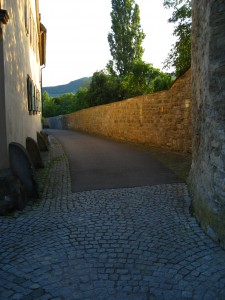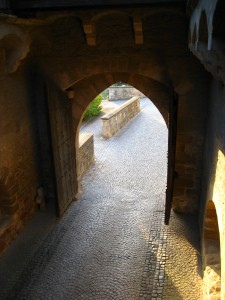
City Gates & the Hue and Cry
Trapped!

It wasn’t easy for a criminal to escape from a walled city. In my last blog post, we looked at how the hue and cry – the victim’s cry for help – brought townsfolk out onto the streets to start chasing the lawbreaker. The city walls and closely spaced houses amplified the noise, making it an effective technique. But the hue and cry did something else. As the shouting spread from mouth to mouth, the cry often reached the city gates before the villain did. As soon it reached the watchmen, they slammed those gates shut.
An Aid in Criminal Investigations

Even if the pursuing citizenry couldn’t catch anyone right away, the ability to ensnare an unknown suspect within the city walls gave the investigator a tremendous leg up. He could require innkeepers and even private households to provide a list of their guests that, together with a register of the citizens, formed a finite list of suspects. The interplay between the hue and cry and medieval city structure thus played a significant role in Germany’s true crime history.
An integral part of any escape plan, then, had to include a hiding place or a way through the walls. Next week I’ll show you one of the places where criminals hid.
Which walled cities have you visited? How easy would it have been to escape?
Literature:
Mittelalterliches Kriminalmuseum, Rothenburg o.d.T.. Justiz in alter Zeit, vol. 4, Schriftreihe des mittelalterlichen Kriminalmuseums Rotenburg ob der Tauber) p. 383.
Clemens-Peter Bösken. Das Ende der grossen rheinischen Räuber- und Mörderbande (Erfurt: Sutton Verlag 2011) p. 33.
Text & images © Ann Marie Ackermann except for first image from Notre Dame: shutterstock.com by Ana Menendez





So everyone who heard the first yell had to yell themselves?
Your next book can on medieval cities and the effects caused by no one ever getting a good night’s sleep. (“Like Cain Will You Slumber (In 20 Minute Intervals)”)
or did they use earplugs?
The source from the Kriminalmuseum in Rothenburg o.d.T. indicates that people spread the cry from one to another. I suppose they could have stuck candlewax in their ears to shut out the commotion, but why miss out on good entertainment? It didn’t happen every day. Participating helped keep the town safe and in some countries was required by law.
Was anyone convicted of failure to yell?
Interesting question…. I find references in the literature to an obligation to participate in the hue and cry in Germany, England, and Hungary. In England for instance, the Statute of Winchester (1285, 13 Edward 1) required residents to help chase down the criminal if they heard the hue and cry. The only source I can find right offhand mentioning punishment of violations is Bálint’s “Mechanisms of the Hue and Cry in Kolosvár.” Penalties for failure to participate included fines and sequestration of property (p. 46 n. 18). But the source doesn’t differentiate between violations for failure to cry out and failure to chase.